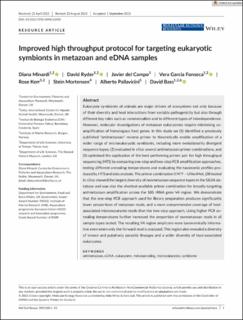| dc.description.abstract | Eukaryote symbionts of animals are major drivers of ecosystems not only because of their diversity and host interactions from variable pathogenicity but also through different key roles such as commensalism and to different types of interdependence. However, molecular investigations of metazoan eukaryomes require minimising coamplification of homologous host genes. In this study we (1) identified a previously published “antimetazoan” reverse primer to theoretically enable amplification of a wider range of microeukaryotic symbionts, including more evolutionarily divergent sequence types, (2) evaluated in silico several antimetazoan primer combinations, and (3) optimised the application of the best performing primer pair for high throughput sequencing (HTS) by comparing one-step and two-step PCR amplification approaches, testing different annealing temperatures and evaluating the taxonomic profiles produced by HTS and data analysis. The primer combination 574*F – UNonMet_DB tested in silico showed the largest diversity of nonmetazoan sequence types in the SILVA database and was also the shortest available primer combination for broadly-targeting antimetazoan amplification across the 18S rRNA gene V4 region. We demonstrate that the one-step PCR approach used for library preparation produces significantly lower proportions of metazoan reads, and a more comprehensive coverage of host-associated microeukaryote reads than the two-step approach. Using higher PCR annealing temperatures further increased the proportion of nonmetazoan reads in all sample types tested. The resulting V4 region amplicons were taxonomically informative even when only the forward read is analysed. This region also revealed a diversity of known and putatively parasitic lineages and a wider diversity of host-associated eukaryotes. | en_US |
